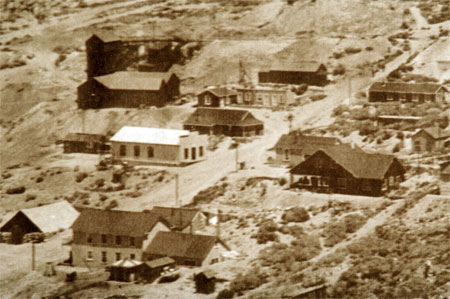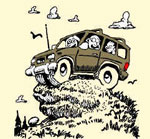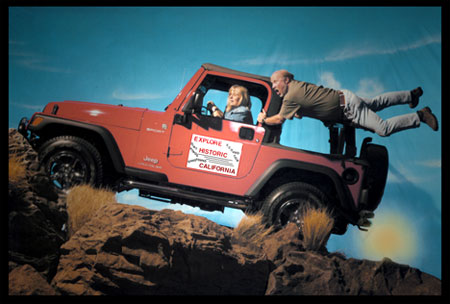
|
READ
ABOUT US! |
|

Bill
Becher, L.A. Daily News outdoor writer and photographer
went to Bodie with us in September. Read what he wrote about the trip. Click
the photo to link to the story. |
|
|
|
TIME
TO
RENEW!
The
birth of a new year is also the death of California campfire
permits issued in 2004. Visit your local land management agency (BLM,
NPS, USFS or State Parks) to renew your campfire permit for the
2005 calendar year.
|
|
Click on
the photo below to read more about Cerro Gordo.

|
|
|
|
BOOK
A TOUR
BUY
STUFF
Ecological
4-Wheeling Adventures
Click
on either graphic below to get there.

Ecological 4-Wheeling Adventures (ECO4WD) offers more than 20 exciting four wheel drive backcountry adventure tours, SUV excursions, 4WD classes and 4-wheeling trainings.
Their adventure tours range from one-day outings into Southern California's mountains and deserts to SUV mini-vacations in Death Valley, whale watching (4WD not required!) on the Baja peninsula and a 12-day, surprising luxurious expedition (no camping) into the uncharted depths of Mexico's Copper Canyon
(Barranca del Cobre). Their "clean and easy" eco-tour style is sensitive and responsible to the environment, your
family and your four wheel drive vehicle.
 |
|
|
|
Don't have a 4X and want to
visit historic sites in Eastern California?
Capture the spirit of the past as it comes alive with true tales of pioneer families, prospectors, muleskinners, hero's and gunslingers. Listen to legends of lost gold, found wealth and superstitions.
Journey back in time with Terri Geissinger - Historian, Interpreter and Guide

Click on Terri's yellow van for Terri's
Ghost Town Tours or
contact Terri by clicking here:

|
|
|
|

The
Panamint Breeze
is a new publication highlighting the history and legends
California and Nevada.
Click
on the logo to
request subscription information. |
|
|
The
Great Floods of the San Gabriel Mountains
by
Cecile Page Vargo
|
|
California, land of little rain. Some years are so dry one forgets what moisture
is. Then comes the rain years, and at times it's as if God turned the
faucet on and forgot to turn it off. Yearly rain averages can be hard to
calculate for this reason. Recent January 2005 rains dumped more water
in a few days than all of 2004. Throughout recorded history this is not
uncommon. Unfortunately these dry periods followed by short periods of large
amounts of rainfall make many areas of California
ripe for catastrophic floods. The
San Gabriel Mountains
north of the City of Los Angeles, and the communities that built up in and around the mountain have been
molded and shaped by the great rainfalls and the destruction they
caused.
 |
|
Cars detour
around a portion of Big Tujunga Road washed out by the waters of
Big Tujunga Creek in January, 2005. |
Part
I:
Camps & Resorts Rise and
Fall With The Flood Waters
Eldoradoville
"There has been some excitement this past week about the new
gold diggings on the headwaters of the San Gabriel. We have met persons who have been out prospecting and although they
found gold of the best quality, differ very much as the regards the
richness of the mines. The Crab Hollow diggings are now considered the
best and will pay from two to five cents to the pan. It is understood
that if the river can be turned from its present bed, some rich leads
may be found and big piles realized." The
Los Angeles
Star,
September 21, 1854
.
The lure of gold brought men to the San Gabriel
Canyon, with the big rush coming in 1859. The first mining camp was set up to
supply needs of the miners and a place for them to spend their gold.
Prospect Bar was located four miles up the East Fork, near the
stream and Cattle
Canyon. The Little Falls Company, and McClure & Company were just two of
many mining operations that sprang up. "The former have constructed
a flume several hundred feet in length, and of sufficient capacity to
carry the waters of the
San Gabriel
at a high stage...The later of the parties named above are engaged in
putting up a hydraulic pump for the purpose of washing a hill
claim." The Southern Vineyard,
August 23, 1859
"A dam has been constructed which lays bare a large section
of the river bed, which they have found quite rich…" The
Star,
November 5, 1859
By December 3rd, the Star
was describing devastation caused by heavy rainfall a few weeks after
the construction of the dam: "We
regret to have to record the total demolition of the
mining works in the San Gabriel Canyon...So tremendous was the
force of the torrent rushing down, that it swept away as chaff all the
mining works erected on the river--dams, wheels sluices, everything, in
fact. The amount of damage
sustained by miners cannot be calculated."
Within a month, San Gabriel
Canyon
prospectors had rebuilt their dams, waterwheels and sluices, and gold
was being pulled out once again. The Eldoradoville Mining District was
formed by March of 1860, and the town of
Eldoradoville
took Prospect Bar's place. Eldoradoville was a rowdy town with no law,
just the justice of a knife or pistol. Three stores, and
half dozen saloons accommodated the miners needs. By August 1861,
the Wells Fargo & Company reported shipments of gold from their
Los Angeles
office, averaging $15,000 in a six month period, primarily from the San Gabriel
Canyon
mines.
The night of
January 17th-18th, 1862
Eldoradoville was hit by a
torrential cloudburst once again. The East Fork turned into a flood of
churning gray water intent on destroying everything in it came across.
The residents of the town managed to climb the hillsides to safety, but
the town was washed away. Shacks, whiskey barrels, groceries, beds,
roulette wheels, sluices, long toms, wing dams and China
pumps were swept into the floodplain of the
San Gabriel
Valley. Eldoradoville was destroyed by the same forces of nature that had hit
Prospect Bar; only mud and debris remained. The boom mining days on the
East Fork of the San Gabriel
River were gone.
Read
More
|
Follows
Camp
by
Cecile Page Vargo
|
|
Brothers,
Ralph and Jack Follows arrived in Azusa
in 1891 from
England, hoping the therapeutic powers of the
San Gabriel
Canyon
would cure Ralph's tuberculosis. They rented a cabin on the old Ferguson
property in the lower East Fork. As Ralph's health improved, he
turned the little cabin into a short-order restaurant for canyon
travelers and miners. In
1896, the Henry Roberts property upstream from the Ferguson
place was in his name, and he began
work on what was to become the largest most famous camp in the San Gabriel
Canyon.
Ralph married Jennie Heaton, the daughter of one of the
miners, the following year. Together
they turned Follows Camp into a place noted for "Good home
cooking, a genial friendliness and welcome, good fishing and
glorious scenery were the attractions." An early brochure touted that camp life was "spent in
real comfort. The tents
are all good size, well floored, cozily furnished and are kept
spotlessly clean. Where
guests may prefer, homelike rooms may be reserved. The camp is
provided with bath tubs, shower baths and plunge bath - and every
modern arrangement has been incorporated to insure perfect
sanitation and health throughout the camp. Pure mountain water is
pumped by a private water plant which Mr. Follows has installed at
enormous expense. Mountain
fruits and vegetables, rich milk and fresh eggs are produced on the
premises. The table is always supplied with fresh meats and
seasonable delicacies, and ice is brought up daily on the
stage."
In spite of his own battle with
tuberculosis, Follows was unsympathetic to others suffering from the
disease. Brochures for
Camp
Follows
sternly announced "NO CONSUMPTIVES ADMIITED. This rule is absolute and no deviation from it will be
made!"
The four-horse Follows Stage was
famous for hauling guests up the grueling twelve mile canyon road.
Upon arrival in camp there were accommodations for over 200
guests...Thousands of people came from all over the west to stay in
the camp over the years. If
one was lucky
during their stay, early-day film stars such as Mabel Normand and
Fatty Arbuckle would be filming silent movies. Guests sometimes
found themselves being used as extras in the old Westerns, as did
Follows himself, his
stage and four horses, and the hired
hands.
Read
More
|
|
Our Tours with
Ecological 4-Wheeling Adventures |
|

Our 2004 tour schedule is
complete and
we're doing some less
strenuous driving!
Please check back for our 2005 tour schedule.
|
|
Explore Historic California! |
|
Not too many years ago, the family station wagon was the
magic carpet to adventure. Today, that family station wagon is likely to
be a four wheel drive sport utility vehicle or pick up truck. SUV's and
other 4x4's are one of the best selling classes of vehicles. Ironically,
industry statistics show that once purchased, few owners will dare to
drive their vehicles off the paved highway. Click your mouse through our
website and enjoy our armchair adventures and the histories behind them.
If you are interested in taking one of our guided tours with your
vehicle, please visit our ECOLOGICAL 4-WHEELING ADVENTURES.
Several years ago, we bought our first SUV. We went to a one-night class
at a local community college entitled "How to 4-Wheel Drive" by Harry Lewellyn.
The following weekend we attended the hands-on day tour. We liked what we were
doing so much that we began going out nearly every weekend and learned how to
negotiate a variety of dirt roads. Our spare time was spent doing research on
the history and ecology of our favorite areas. A one-day outing turned into 16
years of leading others on mini-vacations throughout Southern California and the
Owens Valley.
Our 4WD outings involve driving on easy to moderate dirt roads and are
ideally suited to novice and intermediate level drivers. All tours are suitable
for stock vehicles in good condition, although some tours do have vehicle size
restrictions.
Our tours are
operated under permits issued by the Bureau of Land Management, U.S.
Forest Service, and other authorities.
We share our knowledge of the backcountry over the CB radio with our
guests. We frequently stop to explore mining areas, old and new, and ponder the
rocks, plants and animals we may encounter. We'll occasionally visit an old
cabin or deserted mountain lookout.
California has a fascinating history, from geologic unrest and
prehistoric petroglyph scribes to the "Radium Queen of the Mojave" and the
"Human Mole of Black Mountain." Load up your 4X, fasten your seatbelts and get
ready to explore historic California.
Roger, Cecile and Marty |
|
|

